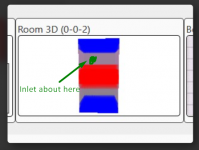You could perhaps alter the box dimensions if the port has no place in optimal spot currently. Making the box shallower or deeper for example, or manipulate other dimensions to get the woofer position so it doesn't excite these so bad. Perhaps even shortening the tube, port diameter would shrink but perhaps it is not still schuffing with regular listening levels.
In this case I suspect it is the 0-0-2 height mode now that contributes most to the mid peak in the port response, as woofer is perhaps on the middle of the width dimension and the width related mode 0-1-0 is not too much excited, lesser of a problem. From this reasoning I would put the port inlet next to compression driver to hit the 0-0-2 mode null even if it was still somewhat on the 0-1-0. 1/3 way on the height, about half way on depth and as center of the width as possible. Could be next to woofer magnet as well if it is more practical place, not sure if this is better or worse position over all.
Your measurement is not as bad as it could be in worst case, there has been some graphs posted where the peak is as high as the helmholz resonance itself! so, if you can make the situation any better it is a win, a problem addressed in context of all problems
In this case I suspect it is the 0-0-2 height mode now that contributes most to the mid peak in the port response, as woofer is perhaps on the middle of the width dimension and the width related mode 0-1-0 is not too much excited, lesser of a problem. From this reasoning I would put the port inlet next to compression driver to hit the 0-0-2 mode null even if it was still somewhat on the 0-1-0. 1/3 way on the height, about half way on depth and as center of the width as possible. Could be next to woofer magnet as well if it is more practical place, not sure if this is better or worse position over all.
Your measurement is not as bad as it could be in worst case, there has been some graphs posted where the peak is as high as the helmholz resonance itself! so, if you can make the situation any better it is a win, a problem addressed in context of all problems
Attachments
Last edited:
I spent some hours to place an ellbow vent into the bottom corner of the existing enclosure (complicated!), so that the air intake of the vent would be placed behind the woofer, where the pressure of the main modes should be the lowest. In the course of this, I had also placed a pillow with filling around the waveguide and compression driver for further reduction of standing waves. The result did not persuade me very much, it was a reduction of - 4dB only:
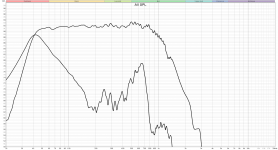
I had recently seen an example of how Neumann had executed counter measures against pipe resonance and was thinking to add this to the ellbow vent, however, decided it was too much hustle for now: the same should first be tested with the straight vent that is sitting in the mid of the enclosure. I used some of the pool liner fleece to cover a hole in a paper tube:
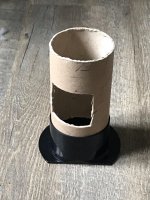
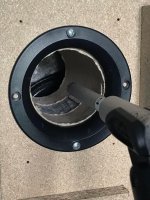
Without changing the vent position, this led to a reduction of -8 dB (red) compared to the original setup (blue). Some of the effect could be related to the pillow filling that was added, I have not measured again without it:
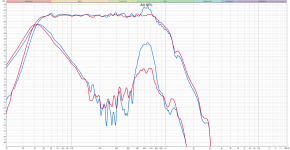

I had recently seen an example of how Neumann had executed counter measures against pipe resonance and was thinking to add this to the ellbow vent, however, decided it was too much hustle for now: the same should first be tested with the straight vent that is sitting in the mid of the enclosure. I used some of the pool liner fleece to cover a hole in a paper tube:


Without changing the vent position, this led to a reduction of -8 dB (red) compared to the original setup (blue). Some of the effect could be related to the pillow filling that was added, I have not measured again without it:

Hello people,
One question keeps going around in my head: should I add cardioid?
In some videos, people expressed their subjective impression that with a cardioid bass response or very low baffle step, even a wide radiation pattern produces the precise image. So I can have both, spaciousness and precise imaging, nice!
My last compromise in modelling was to go for a wider baffle. Here, the simulation is for 40 cm total width box, including the slanted bevels, and yes, waveguide is still a bit hot:
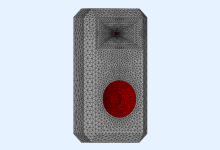
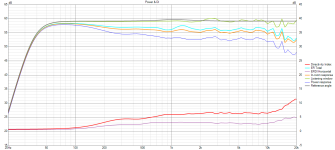
This wider baffle helps with a low XO frequency wide pattern speaker, because baffle-edge diffraction would otherwise rip into the horizontal pattern. Nice side effect of this shallow-wide enclosure is quite a low baffle-step already. But Grimm LS1 width (50 cm) is out of reach, I do not have the estate.
So, how about adding a woofer to the back then?
Thing is the volume needed. The speakers currently run ported on 30 liters, the above enclosure is for 36 liters.
I would probably switch to a closed, or better two internally seperate enclosures, and Linkwitz-transform them. For the PHL 3411, 18 liters work when the midwoofer only plays to 50 Hertz. The idea is a "low-cadioid" pattern, where below 50 Hertz. the woofers radiate omni and a lot of energy is saved. This is what Bruno Putzey did with the Kii speakers and I think what Dutch&Dutch do. In the Sound & Recording review of the GGNTKT M1 by Anselm Goertz he wrote there was not a significant difference after room correction compared to full cardioid.
So what I am looking for is an efficient 10 inch subwoofer (probably could fit a 12 inch too) that could play to 200 Hz in ... 18 liters?
Can I make this work with some Class D power, and can I have some suggestions on the hardware?
One question keeps going around in my head: should I add cardioid?
In some videos, people expressed their subjective impression that with a cardioid bass response or very low baffle step, even a wide radiation pattern produces the precise image. So I can have both, spaciousness and precise imaging, nice!
My last compromise in modelling was to go for a wider baffle. Here, the simulation is for 40 cm total width box, including the slanted bevels, and yes, waveguide is still a bit hot:


This wider baffle helps with a low XO frequency wide pattern speaker, because baffle-edge diffraction would otherwise rip into the horizontal pattern. Nice side effect of this shallow-wide enclosure is quite a low baffle-step already. But Grimm LS1 width (50 cm) is out of reach, I do not have the estate.
So, how about adding a woofer to the back then?
Thing is the volume needed. The speakers currently run ported on 30 liters, the above enclosure is for 36 liters.
I would probably switch to a closed, or better two internally seperate enclosures, and Linkwitz-transform them. For the PHL 3411, 18 liters work when the midwoofer only plays to 50 Hertz. The idea is a "low-cadioid" pattern, where below 50 Hertz. the woofers radiate omni and a lot of energy is saved. This is what Bruno Putzey did with the Kii speakers and I think what Dutch&Dutch do. In the Sound & Recording review of the GGNTKT M1 by Anselm Goertz he wrote there was not a significant difference after room correction compared to full cardioid.
So what I am looking for is an efficient 10 inch subwoofer (probably could fit a 12 inch too) that could play to 200 Hz in ... 18 liters?
Can I make this work with some Class D power, and can I have some suggestions on the hardware?
Do the subs and midwoofer of the D&D 8c share the same enclosure internal space?
From this picture, it looks as if they had only inserted a panel behind the midwoofer to block immediate backwave of the subwoofers: http://6moons.com/audioreviews2/dutchdutch/3.jpg
Edit:
Here, the sheet is still missing: https://www.audiosciencereview.com/forum/index.php?attachments/p6300035-jpg.233287/
What is also visible though is that the midwoofer is connected to the main compartment via a small slot.
On this picture, it looks as if the wood sheet is visible, placed somewhat behind the cardioid slots: https://www.audiosciencereview.com/forum/index.php?attachments/p6300033-jpg.233285/
Pics taken from this thread https://www.audiosciencereview.com/...r-and-listening-session-with-many-pics.37788/ and this review http://6moons.com/audioreviews2/dutchdutch/1.html
From this picture, it looks as if they had only inserted a panel behind the midwoofer to block immediate backwave of the subwoofers: http://6moons.com/audioreviews2/dutchdutch/3.jpg
Edit:
Here, the sheet is still missing: https://www.audiosciencereview.com/forum/index.php?attachments/p6300035-jpg.233287/
What is also visible though is that the midwoofer is connected to the main compartment via a small slot.
On this picture, it looks as if the wood sheet is visible, placed somewhat behind the cardioid slots: https://www.audiosciencereview.com/forum/index.php?attachments/p6300033-jpg.233285/
Pics taken from this thread https://www.audiosciencereview.com/...r-and-listening-session-with-many-pics.37788/ and this review http://6moons.com/audioreviews2/dutchdutch/1.html
Last edited:
I finally found a tonal balance that fully persuades me with the big 2-way constant directivity speaker, and thought I would document it. The waveguide that I am still using is a 90 x 60 waveguide which reaches a DI of 10 at 20 kHz and sets off a DI of 7 at the crossover (old graph). The results with toning wide band filters always sounded dull to my ear, even if significantly decreased in magnitude. One issue was that I found the speaker to sometimes lack clarity in the lower mids and bass, and that the definition of the tweeter stood out too prominently. So, to shorten things a bit, I failed with proper in-room bass equalization, to begin with. When I tried to integrate the two ways by toning the global response, the balance between too much tweeter rendition and too much lower energy never fell into place. Well, it still sounded very nice, but I suspected it could sound better and when I recently listened to a very clean sounding speaker, I decided use more force.
First, I cut the bass shelf twice: fighting room modes with PEQs and a Lowshelf fc: 85 Hz, Q: 0.7 gain: -7 dB! This is from anechoic flat, meaning there is BSC filter in place that I could also have removed. What remained was a ca. 2 dB minimal bass shelf below 100 Hz. The sound was very articulate but sometimes a bit lean. But the bass was so fast and controlled! (although bass reflex )
)
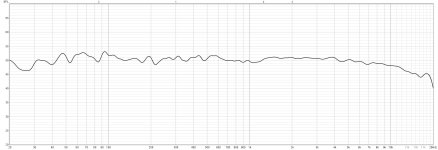
I had previously already lowered the tweeter level by 1 dB, as I had observerd from the Genelec S360 that it was runnig 2 dB lower in level than the woofer, and removed another 0.5 dB. As another model, I looked at the Sound & Recording application of room curves, where in their tests they implement a slope from 100-1.000 Hz, usually a 5 dB difference. As I had enjoyed the very dry sound, I thought 5 dB was way too much and implemented a Highshelf, fc: 300 Hz, Q: 0.6, gain: -2 dB.
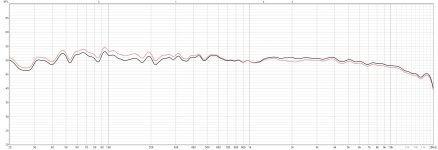
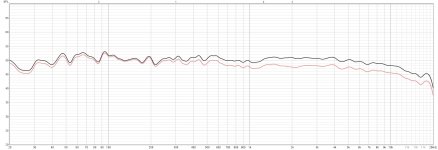
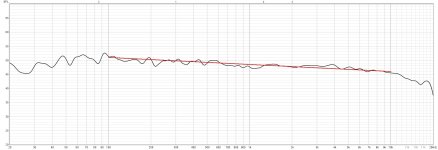
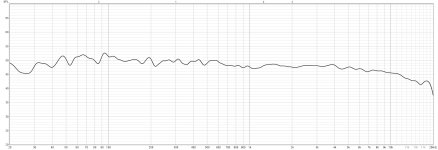
The slope is -5 dB between 100 Hz and 10.000 Hz and it sound very nice. I also cut away some more bass, -1 dB, which made the bass sound more round. If the radiation pattern of the waveguide would not be so stupidly narrow, I'd be good now! See you in two years when I printed my waveguide...
First, I cut the bass shelf twice: fighting room modes with PEQs and a Lowshelf fc: 85 Hz, Q: 0.7 gain: -7 dB! This is from anechoic flat, meaning there is BSC filter in place that I could also have removed. What remained was a ca. 2 dB minimal bass shelf below 100 Hz. The sound was very articulate but sometimes a bit lean. But the bass was so fast and controlled! (although bass reflex

I had previously already lowered the tweeter level by 1 dB, as I had observerd from the Genelec S360 that it was runnig 2 dB lower in level than the woofer, and removed another 0.5 dB. As another model, I looked at the Sound & Recording application of room curves, where in their tests they implement a slope from 100-1.000 Hz, usually a 5 dB difference. As I had enjoyed the very dry sound, I thought 5 dB was way too much and implemented a Highshelf, fc: 300 Hz, Q: 0.6, gain: -2 dB.




The slope is -5 dB between 100 Hz and 10.000 Hz and it sound very nice. I also cut away some more bass, -1 dB, which made the bass sound more round. If the radiation pattern of the waveguide would not be so stupidly narrow, I'd be good now! See you in two years when I printed my waveguide...
Last edited:
If the effects of frequency linear distortion and what it takes to translate a flat anechoic response to the listening space would be a concern for the audio industry, a major market adjustment would sweep away all the useless products and hostile loudspeaker designs. Audio wasn't silly, meaninful choices offered, current state of the art class D and DSP options dead cheap basics and people would enjoy good sound.
Well, I have my chipboard brick, 39 powered filters behind two prosound drivers, and a streamer that's got another DSP in it. I am happy
Well, I have my chipboard brick, 39 powered filters behind two prosound drivers, and a streamer that's got another DSP in it. I am happy
- Home
- Loudspeakers
- Multi-Way
- Driver for JBL 708-ish dimensioned 2-way
